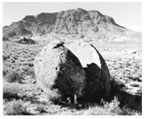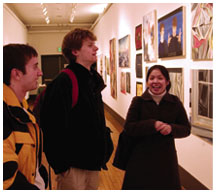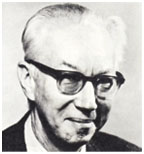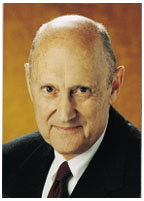February 25, 2004: Notebook
Tuition up 4.5 percent, staffing needs addressed
Financial success possible: Just hold on
B. P. and Ford renew carbon dioxide study
Western landscapes by Robert Adams

The cost of an undergraduate Princeton education will total $38,297 next year, an increase of 4.5 percent.
At its meeting January 24, the Board of Trustees approved a 4.8 percent increase in tuition for 2004—05 and a 5 percent and 1.8 percent increase in room and board, respectively. Tuition will now be $29,910, room $4,315, and board $4,072.
The budget also provides for more staffing in the Graduate School, human resources, health services, and other areas. Also approved was the hiring of additional assistants in instruction and increased funds for the Office of Admission for two admission counselors, new materials, and recruitment programs.
Undergraduate financial aid continues to be one of the fastest growing
components of the University’s budget. In this year’s freshman
class, 52 percent of students received aid. The Priorities Committee,
which submits the University’s budget to the Board for approval,
anticipates that more than half of the students in future classes also
will receive financial aid. A copy of the Priorities Committee report
submitted to the Board of Trustees can be found at
here. ![]()

|
Photo by Ricardo Barros |
Joshua Schulman ’04, left, and Nelson Reveley ’05 join Jean
Su ’05 at the opening of the student art show in the Lucas Gallery
at 185 Nassau February 3. The bi-annual show features work by students
who study painting, sculpture, photography, ceramics, and drawing. The
works, on display through February 19, ranged from a glossy black, high-heeled
ceramic shoe trimmed in turquoise, by Dana Sarnak ’06, to a motorized,
three-foot-long wooden drill bit, by Kristina Fontanez ’05, to an
unsigned series of “Where’s Waldo” photographs featuring
a member of the Princeton band lost in the crowd at a local mall.
![]()

A new cancer drug, developed in part by Princeton professor Edward C. Taylor, was approved February 5 for use in the U.S. The Food and Drug Administration cleared Alimta for the treatment of malignant pleural mesothelioma, an asbestos-related cancer of the lining of the lungs.
Taylor, who taught at the University for 43 years before transferring to emeritus status in 1997, worked in a joint effort with Eli Lilly and Company to develop the cancer-fighting compound.
Alimta is to be used with cisplatin, a chemotherapy agent, to treat
patients with mesothelioma, which affects 10,000 to 15,000 people worldwide
each year. An international trial showed that adding Alimta to a cisplatin
regimen extended patients’ lives by an average of nearly three months,
over use of cisplatin alone, and improved lung function. ![]()

|
(Office of Communications) |
Henry A. Jandl *37, an emeritus professor of architecture who served on the Princeton faculty from 1940 to 1975, died January 3 in Richmond, Virginia; he was 93.
Jandl graduated from Carnegie Mellon University and earned an M.F.A. at Princeton in 1937. He also studied at the école des Beaux-Arts in Paris and at the School of Fine Arts in Fontainebleau, France.
Jandl, a proponent of contemporary design, designed numerous private homes and civic buildings, including the borough halls in Princeton and Hightstown. He also designed additions to Westminster Choir College and Princeton Country Day School.
He served on the University’s advisory board on design and was
secretary-treasurer of the Association of Princeton Graduate Alumni. ![]()

|
Burton Malkiel
*64 |
Get rich slowly. It might not be what people want to hear from their financial advisers, but according to Burton G. Malkiel *64, Princeton’s Chemical Bank Chairman’s Professor of Economics, it’s probably the most honest advice on the market.
Thirty years after publishing his classic book, A Random Walk Down Wall Street, Malkiel has condensed his ideas into a how-to guide for laymen, The Random Walk Guide to Investing: Ten Rules for Financial Success (W. W. Norton). His investment principles are similar to the ones outlined in a 401(k) enrollment packet – diversity, risk, tax-deferred saving – but Malkiel adds much-needed color to the topic. “If you read some of the retirement brochures, it makes investing seem so terribly boring,” he says. “One of the things that I’ve always tried to do, in my teaching and in my writing, is to have the good anecdote or the good amusing story that makes those lessons far more accessible and easier to understand.”
For example, Malkiel extols the virtues of saving by citing Albert Einstein, who called compound interest the “greatest mathematical discovery of all time.” For a common-sense approach to risk tolerance, he calls on J. P. Morgan, who advised a friend whose stock investments were keeping him awake at night to “sell down to the sleeping point.” And Malkiel’s practical tip for curbing spending is to rent movies occasionally, instead of going to the theater. As an added incentive, he shares a recipe for pan-popped popcorn, his self-proclaimed “food weakness.”
The professor’s best-known illustration comes from the original Random Walk, in which he theorized that “the market prices stocks so efficiently that a blindfolded chimpanzee throwing darts at the Wall Street Journal can select a portfolio that performs as well as those managed by the experts.” Drawn from Malkiel’s academic research on efficient market theory, the idea is that stock prices quickly reflect any pertinent news because profit-seeking pros immediately buy or sell, depending on the information. News is unpredictable, as are the changes in stock prices.
If you can’t beat the market, you may be better off joining it. “The right analogy is that you throw a towel over the stock pages, and you simply buy and hold everything,” Malkiel says. For most investors, buying and holding everything simply was not a possibility when he first published Random Walk in 1973, but Malkiel’s friend John Bogle ’51 provided a practical alternative in 1976, introducing the first index mutual fund at Vanguard. With each share, investors could hold every stock in the Standard and Poor’s 500 Index. Today, nearly every fund family has multiple index offerings, and about 10 percent of stock investments are indexed.
As a former investment banker, Malkiel understands the temptation to
try to beat the market. He insists, though, that even the “rock stars”
of the stock market enjoy only fleeting success. Consistently investing
for the future is more important than picking the hot funds. “If
you put $3,000 a year steadily into an I.R.A.,” he notes, “those
small savings can give you well over $1 million in retirement.” ![]()
By B.T.
CORNY BUT GOOD
Burton Malkiel’s instructions for pan-popped popcorn (from The Random Walk Guide to Investing: Ten Rules for Financial Success): “Cover the bottom of a pan with olive oil, put in three kernels, when they pop, cover the bottom with kernels, put a cover on the pan, pop, and then salt to taste. It tastes much better than movie popcorn.”

More than 60 University researchers working to address global carbon and climate issues received a vote of confidence in January when sponsors British Petroleum and Ford Motor Company approved funding of the second phase of a 10-year, $20 million project that began in 2001.
Stephen Pacala, the Frederick D. Petrie [’30] Professor in Ecology and Evolutionary Biology, and Robert Socolow, a professor of mechanical and aerospace engineering, head the multidisciplinary project, called the Carbon Mitigation Initiative, which examines the effects of carbon released into the atmosphere by the burning of fossil fuels, and searches for ways to reduce or store emissions. Carbon dioxide in the atmosphere would increase to five to 10 times its current level if all of the world’s fossil fuels were burned, according to the recently released C.M.I. annual report. Higher levels of carbon dioxide are blamed for adverse changes to the global climate.
The researchers are divided into four groups. One examines alternative
energy sources and lower-emission uses for fossil fuels; another investigates
the feasibility of pumping excess carbon dioxide into deep aquifers; a
third works on modeling environmental factors; and the fourth looks at
policy issues. Project news and annual reports are available at www.princeton.edu/~cmi/.
![]()
By B.T.


On view at the Art Museum
through June 6 are 28 photographs by Robert Adams, including “Mohave,
Quarry County,” above. Adams, using 19th-century photographers William
Bell, William Henry Jackson, and others as examples, traveled to the West
in the mid-1970s to document open spaces that those photographers had
captured but had grown less pristine.
![]()

Princeton has acquired the papers of the Women’s World Bank, which was founded in 1979 to provide financial services to poor women around the world. The archives span the tenure of the bank’s first president, Michaela Walsh. Archivist Dan Linke says that the papers join the library’s already strong economic-development collection and brings diversity to the library’s holdings. “International relations used to be the province of white men,” says Linke, “and our collections reflect that. Women’s World Banking symbolizes the erosion of this monopoly, a process that will only accelerate in the 21st century.”
On January 10, more than a dozen graduate students moved into the first completed building in the addition to the Lawrence Apartments. The remaining six buildings are scheduled for completion in June, and all 206 new units will be occupied in the 2004—05 academic year. The buildings are near the Graduate College and equipped with amenities such as central air-conditioning, says Mark Kirby, an architect and planner in the Office of Physical Planning.
|
Triangle Club |
During spring break, the Triangle Club heads to California for two benefit performances in the Bay Area, where the troupe will perform Ding!, a compilation of Triangle hits over the years. The Princeton Club of Northern California is sponsoring the benefit shows as fundraisers for the Performing Arts Workshop, an award-winning nonprofit organization that serves inner-city at-risk youth. The first performance of Ding! takes place March 13 at Lowell High School in San Francisco; the second March 15 at the Osher Marin Jewish Community Center in San Rafael. Other nonbenefit performances are scheduled for Santa Barbara, March 16; Los Angeles, March 18; and San Diego, March 19. For more information, call 415-243-2286 or online go to www.princeton.edu/~triangle.
Robert Wuthnow, the Gerhard R. Andlinger ’52 Professor of Social Sciences, has received the American Academy of Religion’s Martin E. Marty Award for the Public Understanding of Religion. The award goes to those whose work has a relevance and eloquence that speaks not just to scholars but to the public as well.
The U.S. Department of Health and Human Services has appointed biologist Virginia Zakian, the Harry C. Wiess Professor in the Life Sciences and professor of molecular biology, to a four-year term on its National Advisory General Medical Sciences Council.
Three faculty members recently transferred to emeritus status. They are: Michael Doyle, W. Jason Morgan *64, and Martin Weigert.
Doyle, the Edwards S. Sanford Professor of Politics and International Affairs, taught at Princeton from 1977 to 1984, and rejoined the faculty in 1987. He previously taught at Harvard, Johns Hopkins, and the University of Warwick. He earned his bachelor’s and doctoral degrees from Harvard.
Morgan, the Knox Taylor Professor of Geography and professor of geophysics, earned his bachelor’s degree from the Georgia Institute of Technology. He received his Ph.D. from Princeton in 1964, when he joined the faculty.
Weigert, the Henry L. Hillman Professor in the Life Sciences and professor
of molecular biology, joined the faculty in 1993. A graduate of Haverford
College, he earned his Ph.D. from the University of Pennsylvania. He had
been a researcher at the Salk Institute for Biological Studies in La Jolla,
California, and a senior member of the Institute for Cancer Research and
a professor of human genetics at the University of Pennsylvania.
![]()




